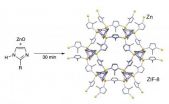(Press-News.org) LA JOLLA, CA – December 2, 2012 – Scientists at The Scripps Research Institute (TSRI) have determined how two proteins help create organelles, or specialized subunits within a cell, that play a vital role in maintaining cell health. This discovery opens the door for research on substances that could interfere with the formation of these organelles and lead to new therapies for cancer.
The study, published online ahead of print on December 2, 2012, by the journal Nature Structural & Molecular Biology, focuses on the structure and function of the two proteins, ATG12 and ATG5. These proteins need to bond correctly to form an organelle called the autophagosome, which acts like a trash bag that removes toxic materials and provides the cell with nutrition through recycling.
"Our study focuses on one of the big mysteries in our field," said Takanori Otomo, the TSRI scientist who led the effort. "These proteins are linked, but no one has explained why clearly. We're very excited to have determined the structure of these linked proteins so that the information is available to do the next level of research."
Asking Questions, Finding Answers
At the beginning of the study, Otomo and colleagues knew that many proteins work together to form autophagosomes as part of the process known as autophagy, which breaks down large proteins, invasive pathogens, cell waste, and toxic materials. As part of this process, one key protein, LC3, attaches to a lipid, or fat molecule, on the autophagosome membrane. Yet LC3 cannot attach to a lipid without the help of ATG12 and ATG5, and a cell will only form an autophagosome if the linkage, or conjugate, between these two molecules has been established.
Otomo and colleagues set out to determine the shape of the ATG12-ATG5 conjugate, and to find out why it was needed for LC3 lipidation.
Using a method called X-ray crystallography, the scientists were able to unveil the details of this conjugate. When ATG12 and ATG5 come together, they form a rigid architecture and create a surface area that is made up of evolutionarily conserved amino acids and facilitates LC3 lipidation. The researchers confirmed this finding by mutating those conserved amino acids , which prevented an autophagosome from forming.
Otomo and colleagues also identified a surface on the ATG12-ATG5 conjugate that binds to ATG3, another enzyme required to attach LC3 to the lipid.
Toward Better Understanding and New Cancer Treatments
With this new knowledge, the researchers hope to design molecules that inhibit autophagosome formation, a direction of research that has implications for cancer treatment. A drug that directly inhibits ATG3 binding, for example, could be used in coordination with current therapies to make cancer treatments more effective, preventing a cancer cell from recycling nutrients and prolonging its survival.
"Ultimately, we'd like to understand the molecular mechanisms of each step of autophagy," he said, "As we make progress toward this goal, we will have a better idea of how to manipulate the pathway for therapeutic purposes. This field is still young and there are a lot of unknowns. This work is just the beginning."
INFORMATION:
In addition to Otomo, authors of the paper, "Structure of the human ATG12~ATG5 conjugate required for LC3 lipidation in autophagy," include Chinatsu Otomo and Zoltan Metlagel of TSRI, and Giichi Takaesu of Keio University in Tokyo, Japan.
This research was supported by National Institutes of Health (NIH) grant GM092740 and by funds from Japan Science and Technology Agency through the Keio Kanrinmaru Project.
Scientists at Scripps Research Institute discover how 2 proteins help keep cells healthy
The work has implications for cancer drug development
2012-12-03
ELSE PRESS RELEASES FROM THIS DATE:
Scientists find 'bully' genes in common childhood tumor
2012-12-03
In a genome sequencing study of 74 neuroblastoma tumors in children, scientists at the Johns Hopkins Kimmel Cancer Center and the Children's Hospital of Philadelphia (CHOP) found that patients with changes in two genes, ARID1A and ARID1B, survive only a quarter as long as patients without the changes. The discovery could eventually lead to early identification of patients with aggressive neuroblastomas who may need additional treatments.
Neuroblastomas affect nerve tissue throughout the body and are the most common, non-blood cancer in children. "These cancers have a ...
Origin of intelligence and mental illness linked to ancient genetic accident
2012-12-03
Scientists have discovered for the first time how humans – and other mammals – have evolved to have intelligence.
Researchers have identified the moment in history when the genes that enabled us to think and reason evolved.
This point 500 million years ago provided our ability to learn complex skills, analyse situations and have flexibility in the way in which we think.
Professor Seth Grant, of the University of Edinburgh, who led the research, said: "One of the greatest scientific problems is to explain how intelligence and complex behaviours arose during evolution." ...
Childhood trauma leaves mark on DNA of some victims
2012-12-03
This press release is available in German.
Abused children are at high risk of anxiety and mood disorders, as traumatic experience induces lasting changes to their gene regulation. Scientists from the Max Planck Institute of Psychiatry in Munich have now documented for the first time that genetic variants of the FKBP5 gene can influence epigenetic alterations in this gene induced by early trauma. In individuals with a genetic predisposition, trauma causes long-term changes in DNA methylation leading to a lasting dysregulation of the stress hormone system. As a result, ...
A shock to pollution in chemistry
2012-12-03
Solvents are omnipresent in the chemical industry, and are a major environmental and safety concern. Therefore the large interest in mechanochemistry: an energy-efficient alternative that avoids using bulk solvents and uses high-frequency milling to drive reactions. Milling is achieved by the intense impact of steel balls in a rapidly moving jar, which hinders the direct observation of underlying chemistry. Scientists have now for the first time studied a milling reaction in real time, using highly penetrating X-rays to observe the surprisingly rapid transformations as ...
Cell surface transporters exploited for cancer drug delivery
2012-12-03
CAMBRIDGE, Mass. (December 2, 2012) –Whitehead Institute scientists report that certain molecules present in high concentrations on the surfaces of many cancer cells could be exploited to funnel lethal toxic molecules into the malignant cells. In such an approach, the overexpression of specific transporters could be exploited to deliver toxic substances into cancer cells.
Although this finding emerges from the study of a single toxic molecule and the protein that it transports, Whitehead Member David Sabatini says this phenomenon could be leveraged more broadly.
"Our ...
Surprising results from study of non-epileptic seizures
2012-12-03
MAYWOOD, Il. - A Loyola University Medical Center neurologist is reporting surprising results of a study of patients who experience both epileptic and non-epileptic seizures.
Non-epileptic seizures resemble epileptic seizures, but are not accompanied by abnormal electrical discharges. Rather, these seizures are believed to be brought on by psychological stresses.
Dr. Diane Thomas reported that 15.7 percent of hospital patients who experienced non-epileptic seizures also had epileptic seizures during the same hospital stay. Previous studies found the percentage of such ...
A better way to make chemicals?
2012-12-03
Bulk solvents, widely used in the chemical industry, pose a serious threat to human health and the environment. As a result, there is growing interest in avoiding their use by relying on "mechanochemistry" – an energy-efficient alternative that uses high-frequency milling to drive reactions. Because milling involves the intense impact of steel balls in rapidly moving jars, however, the underlying chemistry is difficult to observe.
Now, for the first time, scientists have studied a milling reaction in real time, using highly penetrating X-rays to observe the surprisingly ...
Glowing fish shed light on metabolism
2012-12-03
A tiny, translucent zebrafish that glows green when its liver makes glucose has helped an international team of researchers identify a compound that regulates whole-body metabolism and appears to protect obese mice from signs of metabolic disorders.
Led by scientists at the University of California, San Francisco (UCSF), the work demonstrates how a fish smaller than a grain of rice can help screen for drugs to help control obesity, type 2 diabetes and other metabolic disorders, which affect a rising 34 percent of American adults and are major risk factors for cardiovascular ...
Stanford researchers discover master regulator of skin development
2012-12-03
STANFORD, Calif. — The surface of your skin, called the epidermis, is a complex mixture of many different cell types — each with a very specific job. The production, or differentiation, of such a sophisticated tissue requires an immense amount of coordination at the cellular level, and glitches in the process can have disastrous consequences. Now, researchers at the Stanford University School of Medicine have identified a master regulator of this differentiation process.
"Disorders of epidermal differentiation, from skin cancer to eczema, will affect roughly one-half ...
International study points to inflammation as a cause of plaque buildup in heart vessels
2012-12-03
STANFORD, Calif. — Fifteen new genetic regions associated with coronary artery disease have been identified by a large, international consortium of scientists — including researchers at the Stanford University School of Medicine — taking a significant step forward in understanding the root causes of this deadly disease. The new research brings the total number of validated genetic links with heart disease discovered through genome-wide association studies to 46.
Coronary artery disease is the process by which plaque builds up in the wall of heart vessels, eventually leading ...
LAST 30 PRESS RELEASES:
National poll: Less than half of parents say swearing is never OK for kids
Decades of suffering: Long-term mental health outcomes of Kurdish chemical gas attacks
Interactional dynamics of self-assessment and advice in peer reflection on microteaching
When aging affects the young: Revealing the weight of caregiving on teenagers
Can Canada’s health systems handle increased demand during FIFA World Cup?
Autistic and non-autistic faces may “speak a different language” when expressing emotion
No clear evidence that cannabis-based medicines relieve chronic nerve pain
Pioneering second-order nonlinear vibrational nanoscopy for interfacial molecular systems beyond the diffraction limit
Bottleneck in hydrogen distribution jeopardises billions in clean energy
Lung cancer death rates among women in Europe are finally levelling off
Scientists trace microplastics in fertilizer from fields to the beach
The Lancet Obstetrics, Gynecology, & Women’s Health: Taking paracetamol during pregnancy does not increase risk of autism, ADHD or intellectual disabilities, confirms new gold-standard evidence review
Taking paracetamol during pregnancy does not increase risk of autism, ADHD or intellectual disabilities
Harm reduction vending machines in New York State expand access to overdose treatment and drug test strips, UB studies confirm
University of Phoenix releases white paper on Credit for Prior Learning as a catalyst for internal mobility and retention
Canada losing track of salmon health as climate and industrial threats mount
Molecular sieve-confined Pt-FeOx catalysts achieve highly efficient reversible hydrogen cycle of methylcyclohexane-toluene
Investment in farm productivity tools key to reducing greenhouse gas
New review highlights electrochemical pathways to recover uranium from wastewater and seawater
Hidden pollutants in shale gas development raise environmental concerns, new review finds
Discarded cigarette butts transformed into high performance energy storage materials
Researchers highlight role of alternative RNA splicing in schizophrenia
NTU Singapore scientists find new way to disarm antibiotic-resistant bacteria and restore healing in chronic wounds
Research suggests nationwide racial bias in media reporting on gun violence
Revealing the cell’s nanocourier at work
Health impacts of nursing home staffing
Public views about opioid overdose and people with opioid use disorder
Age-related changes in sperm DNA may play a role in autism risk
Ambitious model fails to explain near-death experiences, experts say
Multifaceted effects of inward foreign direct investment on new venture creation
[Press-News.org] Scientists at Scripps Research Institute discover how 2 proteins help keep cells healthyThe work has implications for cancer drug development




